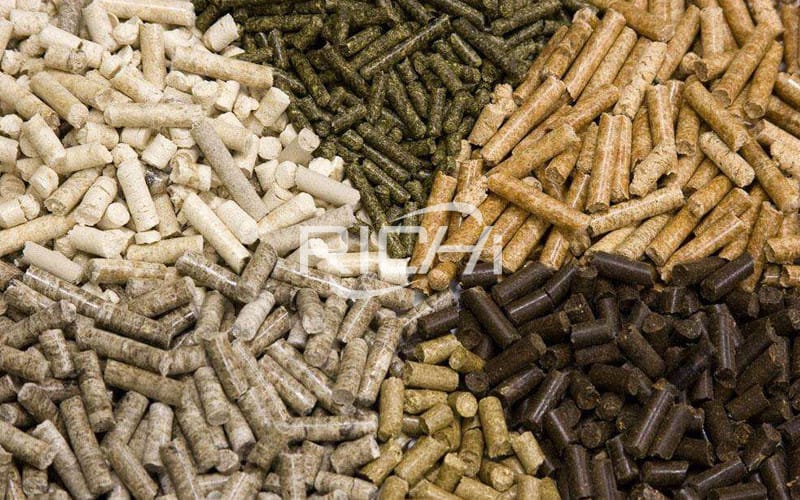Different animal feed, different feed granulation process
With the popularization and application of pellet feed in livestock and poultry, aquatic products and other breeding industries, as well as emerging industries such as compound fertilizers, hops, chrysanthemums, wood chips, peanut shells, and cottonseed meal, more and more units use ring die feed pellet mills. Different formulations and regional differences, users have different requirements for pellet feed. Each feed manufacturer requires good pellet quality and high pelleting efficiency for the pellet feed it produces.
Due to different feed formulations, the selection of ring die parameters when pressing these pellet feeds is also different. The mold parameters are mainly reflected in the choice of material, aperture, hole shape, aspect ratio, and aperture ratio. The selection of ring die parameters must be determined according to the chemical ingredients and physical properties of the various raw materials that make up the feed formula. The chemical ingredients of the raw materials mainly include protein, starch, fat, cellulose and so on. The physical properties of raw materials mainly include particle size, moisture, capacity and so on.

1. Poultry and livestock feed pellets
Livestock and poultry feed mainly contains wheat and corn. The starch content is higher and the fiber content is less. It is a high starch feed. To suppress such feed, it is necessary to ensure that the starch is fully gelatinized to achieve high temperature and processing conditions. The ring die of the animal poultry feed pellet milling machine is generally thicker and has a wider aperture range. The aspect ratio is generally between 1:8-1:10. While broilers and ducks are high-energy feeds, they have a high fat content and are easy to granulate. Generally, the long diameter is relatively large, between 1:10-1:13.
2. Aquatic feed pellets
Aquatic feed mainly includes fish feed, shrimp feed, turtle feed, etc. The crude fiber content in fish feed is high, and the crude fiber content in shrimp feed and turtle feed is low and the protein content is high. It belongs to high protein feed. Aquatic materials require particles to be stable in water for a long time, with a consistent diameter and neat length. This requires fine granulation and high maturity when granulating the material. Pre-ripening and post-ripening processes are used. The ring die aperture of the fish feed pellet mill is generally between θ1.5-θ3.5, and the aspect ratio range is generally between 1:10-1:12.
The aperture of the ring die used for shrimp feed ranges from θ1.5 to θ2.5, and the aspect ratio ranges from 1:11-1:20. The diameter of the ring die used in turtle feed is large, ranging from θ3-θ8. Due to the high protein content, the aspect ratio ranges from 1:12-1:20. The selection of the specific parameters of the aspect ratio must be based on the formula. Nutrition indicators and user requirements are determined. At the same time, the design of the hole shape of the die hole should not use a stepped hole as much as possible under the condition of strength, to ensure that the cut pellets are uniform in length and diameter.
3. Compound fertilizer pellets
The compound fertilizer formula is mainly composed of inorganic fertilizer, organic fertilizer, minerals, etc. The inorganic fertilizer in the compound fertilizer, such as urea, is more corrosive to the ring die, while the minerals are very abrasive to the ring die hole and inner cone hole, and the squeezing force Larger. The diameter of the compound fertilizer ring die is generally large, ranging from θ3-θ6. Due to the large friction coefficient, the die hole is difficult to discharge, so the long diameter is relatively small, generally between 1:4-1:6, and because of the compound fertilizer Containing bacterial species, the temperature can not exceed 50-60 degrees, otherwise it is easy to kill the vaccine.
Therefore, the compound fertilizer requires lower granulation temperature and generally thinner ring mold wall thickness. Because compound fertilizer wears on the ring die holes severely, the requirements on the hole diameter are not strict. Generally, the ring die of feed pellet machine is scrapped when the gap between the pressure rollers cannot be adjusted. Therefore, the length of the stepped hole ensures the length-to-diameter ratio and improves the final service life of the ring die.
4. Hop pellets
Hops have a high content of brazing dimension and contain bacteria, and the temperature generally cannot exceed 50 degrees. Therefore, the ring die of pellet making machine for pressing hops has a thinner wall thickness and a shorter long diameter, generally about 1:5, and the particle diameter is larger, at θ5- between θ6.
5. Other pellets
Chrysanthemums, peanut shells, cottonseed meal, wood chips contain a large amount of roughness, the content of roughness is more than 20%, the oil content is low, the material penetrates through the friction of the die hole, the granulation performance is poor, and the hardness of the granule is required It is difficult to meet the requirements when the concentration can be reduced. The pellet diameter and pore size are generally between θ6-θ8, and the aspect ratio is generally about 1:4-1:6. Due to the small bulk density of the feed and the large hole diameter of the die hole, the outer circle of the die hole area must be sealed with tape before granulation. The gate allows the material to be fully filled into the die hole to form, and then tear the tape. For the granulation of various materials, the correct ring die parameters and operating conditions must be selected according to the material characteristics of the materials and the specific characteristics of each feed manufacturer. According to local conditions, high-quality feed pellets can be produced.
Recommend the following series of ring die animal poultry livestock aqua fish shrimp feed pellet mill equipment:
If you want to built one complete pellet production line in your country, pls send the inquiry to us. We will customized design according to your requirement.



